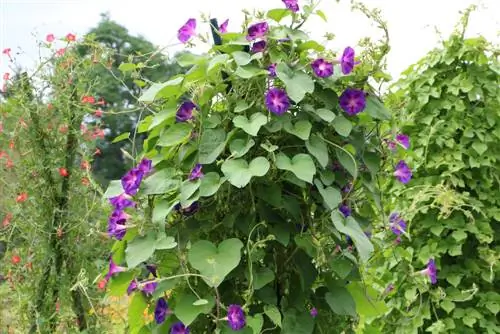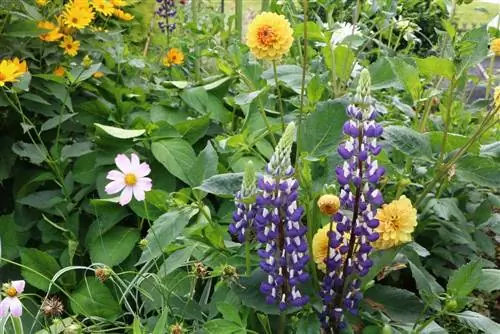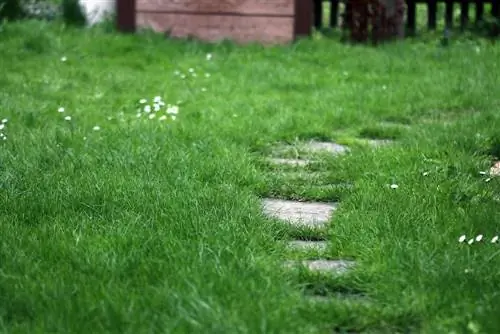- Author admin [email protected].
- Public 2023-12-17 03:39.
- Last modified 2025-06-01 06:48.
The annual morning glory, botanically Ipomoea, also called morning glory or morning glory, is an undemanding, fast-growing climbing plant. It impresses with its large funnel-shaped flowers, variety of colors and ability to quickly develop into a true garden beauty. This easy-care climbing plant is ideal as a quick privacy screen and for hiding ugly garden corners. Flower colors ranging from red, pink, violet, light blue, light brown to white can be admired from June onwards.
As undemanding as the plant is, it should still be enjoyed with a little caution. The fruit capsule, seeds and, to a lesser extent, the leaves and stems are poisonous, especially to small children and pets.
Sowing & Growing:
It is recommended to use a special potting soil. Standard potting soil generally has a high level of fertilizers, which will burn the young roots. Here are more tips for a large floral display.
- Best before date on the seed bag should not be exceeded
- Water seeds for 24 hours before sowing, this improves germination
- Sowing in pots at approx. 20°C room temperature from mid-March, maximum 3 seeds per pot
- after approx. 5 - 14 days the first seedlings will appear
- After starting the climbing, place them individually in small pots (single) and provide climbing aids
Location
The frost-sensitive morning glory should not be planted outdoors until about a week after the ice saints at the earliest. The best time is the end of May or the beginning of June.
Locations in full sun are particularly suitable. Although it also thrives in partial shade, it develops significantly fewer and smaller flowers there than it would in full sun.
You don't need to worry about the quality and condition of the soil with the undemanding morning glory. This plant thrives in almost all soils. Provided there is some soil available, you can even plant them in gravel beds.
The individual plants should not be too close together, otherwise they will die. The optimal planting distance is indicated on the seed bags.
Trails
All species of winds have the ability to find their own climbing help. Therefore, care should be taken to ensure that suitable climbing material is provided. If there are no climbing aids available, the morning glory also uses existing plants to climb up. This behavior can potentially damage the plant.
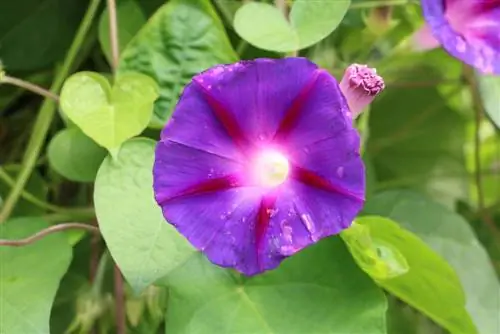
In addition to the climbing aids that are offered in hardware stores and garden centers, you can also use branches from the shrub cuttings from the previous year, for example. Wire mesh fences or pergolas covered with morning glories are also visually appealing. A quick alternative is to tension a wire or rope. This can be dismantled again in the fall with little effort. It is even easier to use natural materials such as coconut or hemp fibers. After the plant dies, they can be disposed of directly with the plant in the compost or organic waste bin.
When building a climbing aid yourself, you don't need to pay attention to its beauty. Within a very short time this will be covered by the heart-shaped foliage.
Other uses:
- hanging in hanging baskets on the terrace or balcony
- as a companion plant for climbing roses, for a colorful accent
- as a ground cover to quickly green larger areas
- as a splash of color in a mixed bed, but only with a pyramid-shaped trellis frame, otherwise it will spread everywhere
Care
For rapid and lush growth, you should not miss out on regular fertilization and watering, especially during the growing phase. It is recommended to use a mineral fertilizer once a month that contains a higher proportion of potassium. This not only promotes the growth of the plant, but also ensures abundant flowers with greater color intensity.
Of course, watering should be carried out regularly in prolonged dry periods, even if the plant has already grown. In order to increase flowering, old, faded flowers should also be regularly pinched off.
Diseases & Pests
Whitefly: This pest is often found on morning glories. The small, winged louse prefers to suck on the underside of leaves. The suction points then turn yellowish. This causes the leaves to dry out and eventually fall off.
As soon as an infestation is detected, this pest should be combated as quickly as possible with an appropriate insecticide, as it moves very quickly from one plant to the next. The treatment should be carried out several times at intervals of three to four days, as this will also kill the more resistant larvae.
Red spider: The larvae of the red spider mite also suck the juice from the leaves. Since they only grow to 0.6 millimeters in size, they are hardly noticeable at first glance. Infestation is usually only noticeable when leaves that have already been infected curl up and die. A severe infestation can cause the entire plant to die.
Here, too, the infestation should be treated with an appropriate insecticide to prevent other plants from being infected.
If you want to avoid using chemical insecticides and rely entirely on the biological destruction of pests, you should use the predatory mite. This beneficial insect feeds on the pest larvae without damaging the plant.
Propagation
Annual summer flowers, like the morning glories here, serve as seed donors for the next summer. The old inflorescences produce seed capsules, which can easily be collected. These are stored in a cool, dry and dark place. Before you start sowing in March, a germination sample should be made in a pot. If half of the seeds sprout, then sowing is worth it.
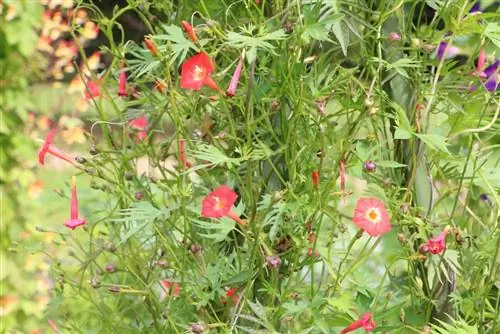
All types can be sown from mid-March in cold frames or seed trays on the room window. Depending on the species, the first seedlings appear in five to 14 days and are soon transplanted into small pots. After the Ice Saints, the pot balls are left in the garden. 1. purpurea can also be sown outdoors in April. If you want a row, space them 30 to 50 centimeters apart. Perennial species are propagated by division or head cuttings. Sowing is possible, but you have to be patient until flowers appear.
The cultivation takes place by sowing. Take 1 - 3 seeds per pot and press them deep into the soil. The imperial morning glory quickly develops long shoots on the windowsill, but it can only be put outside in May.
Interesting facts
Morning glories (Ipomoea) from the morning glories family (Convolvulaceae) are widespread in the warmer zones of the world, but especially in the tropical areas of America. There are also species with tuberous rhizomes that are eaten as a substitute for potatoes. They are called “Bataten” or “Sweet Potatoes” there.
The morning glory is a twining herb, closely related to our morning glory. In a short time, the long shoots find support on any trellis and grow up to 3 m high. The sky-blue funnel flowers open early in the morning; similar species bloom dark purple and red. In the afternoon, however, the splendor is already over.
Conclusion
For impatient hobby gardeners, the morning glory is exactly the right summer flower to get a wonderfully bright sea of flowers quickly and easily thanks to its variety of colors, shapes and possible uses. Simple elegance and sporty growth without great demands make the morning glory a must in every garden.
Summary
Morning glories can be used in many different ways. They quickly and densely cover walls, pergolas and arbors, and are suitable for garnishing bare tree trunks or pillars. You can also make free-standing privacy walls out of wire mesh, high-tension cords or trellis slats, onto which the vines can climb from boxes or buckets. Balcony walls can also be covered with vines. Pea grids, a pyramid made of bean stalks, a tube made of wire mesh several meters high or even large branches anchored in the ground offer a very distinctive flower display covered with morning glories. Whether you place it exposed on a slab surface, terrace or in a lawn or as a permanent bloomer between trees or in a herbaceous bed: all morning glories need nutritious and slightly calcareous soil and want to be in a sunny, warm, protected place. The fertilizer should contain plenty of potash and phosphorus to increase the colorful vibrancy of the flowers. Being in a drafty, cold, or otherwise inconvenient place will only result in failure.

